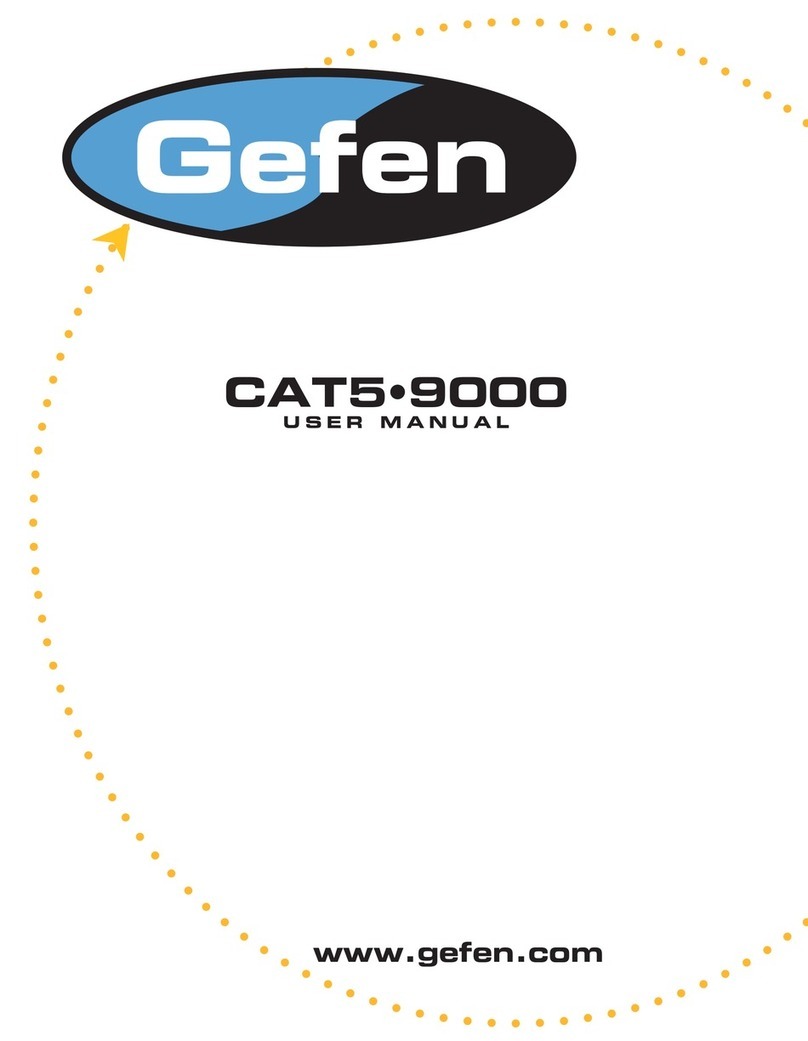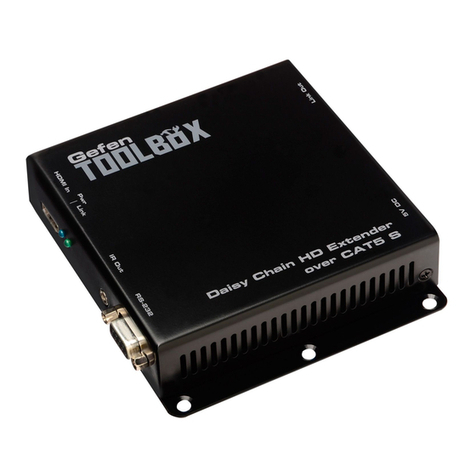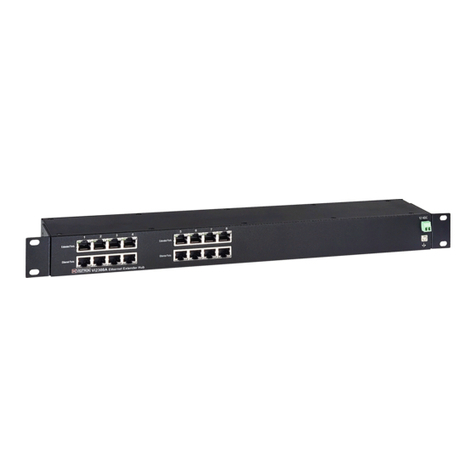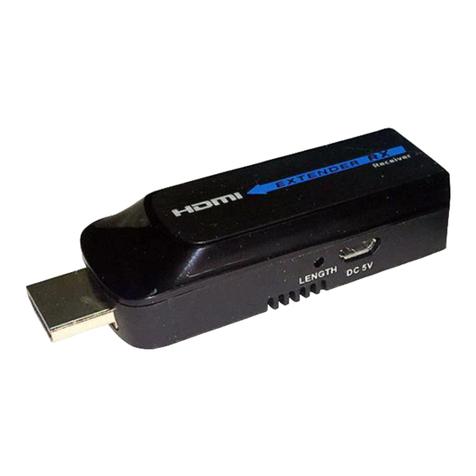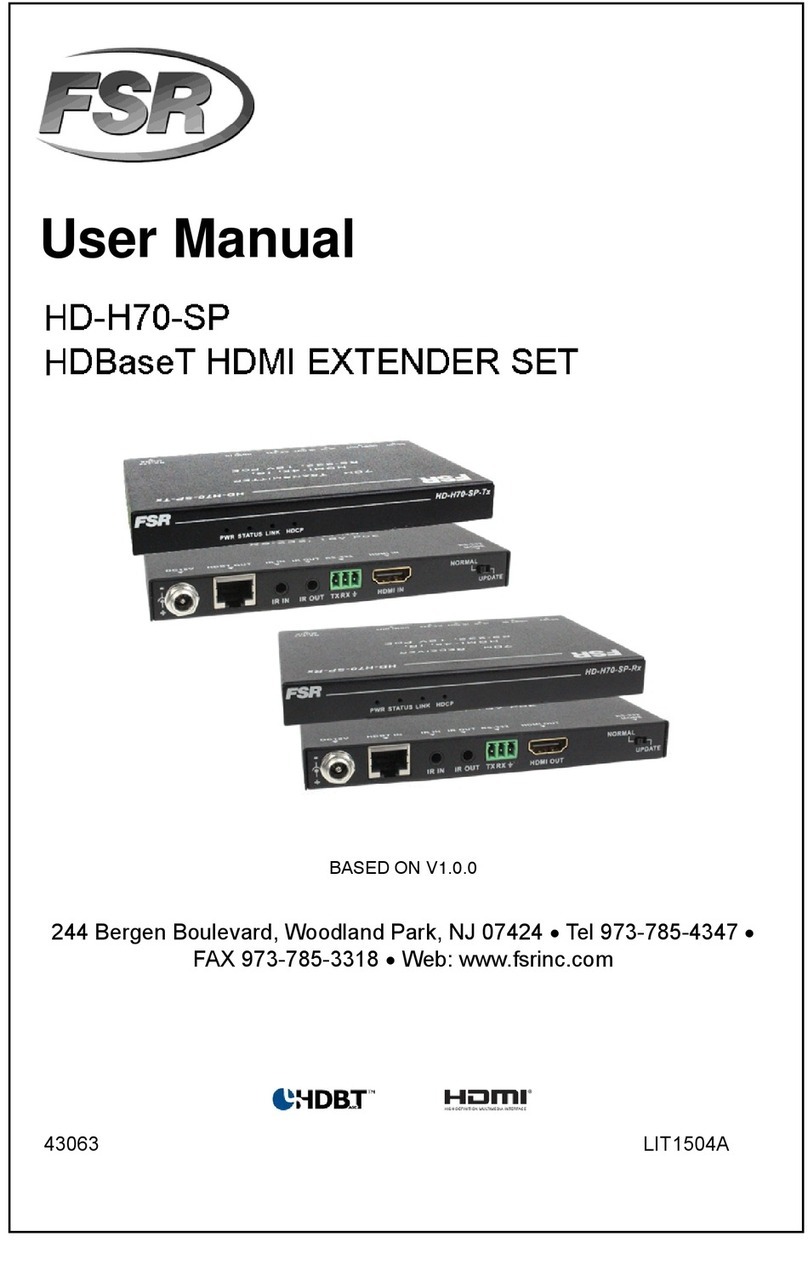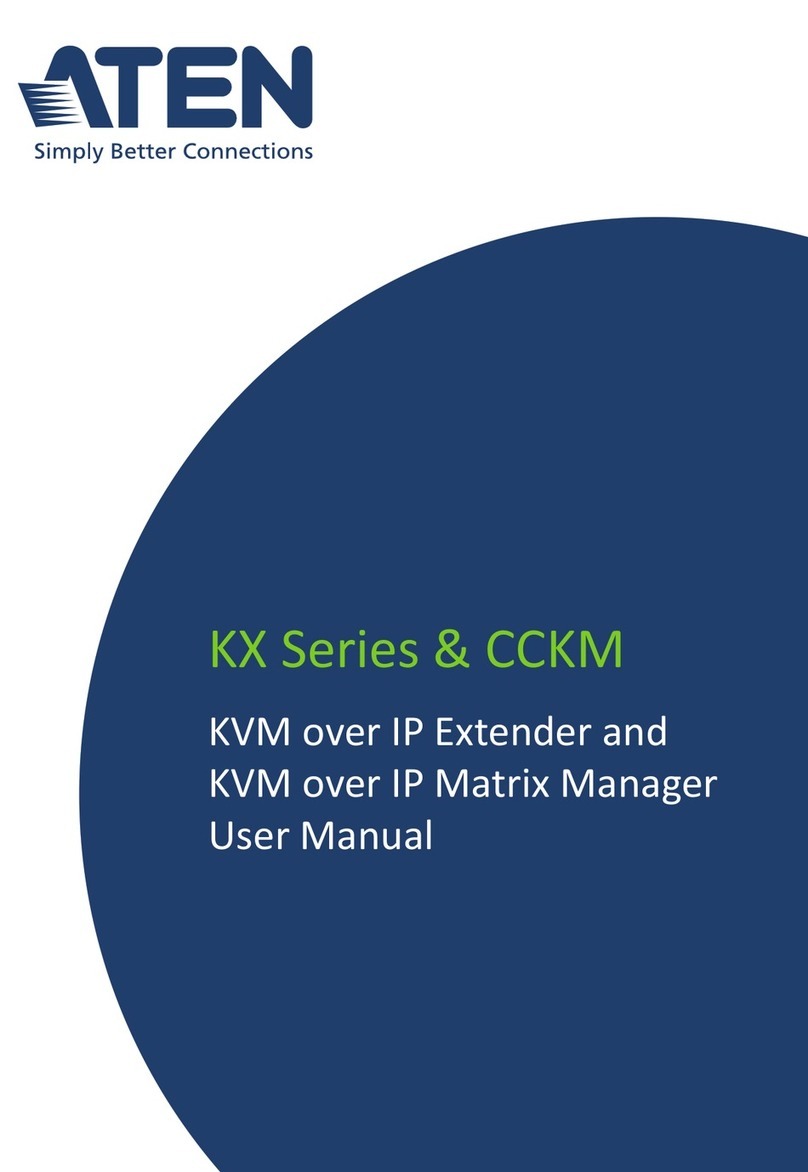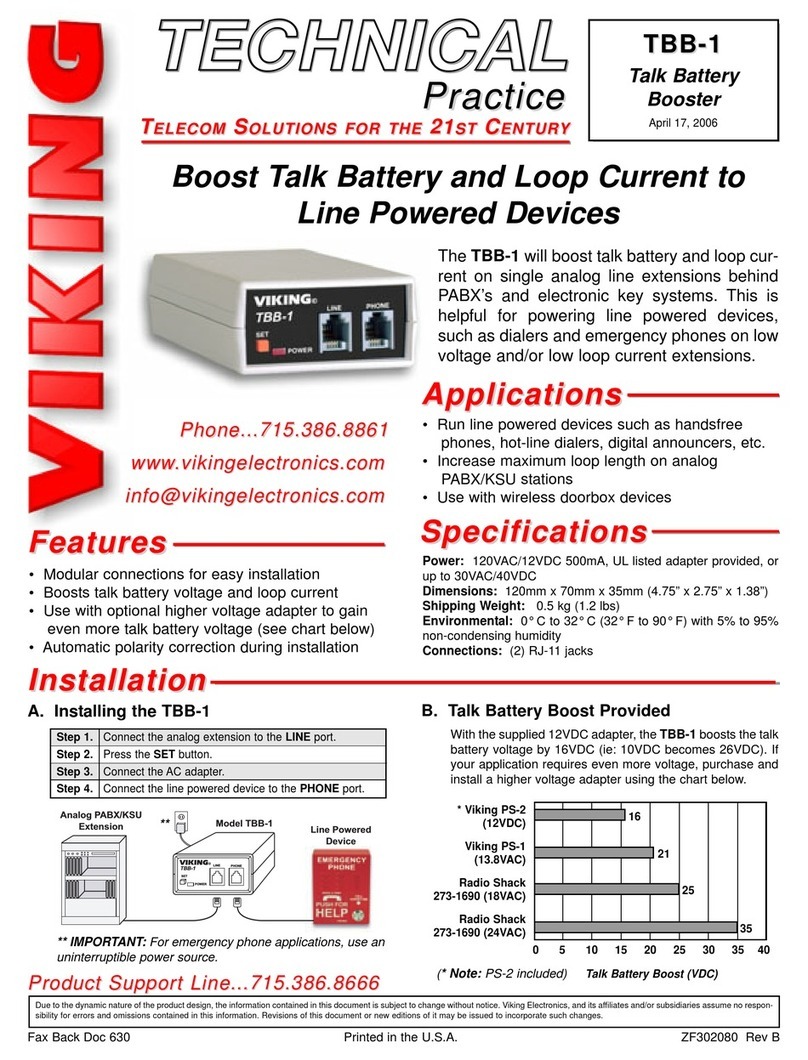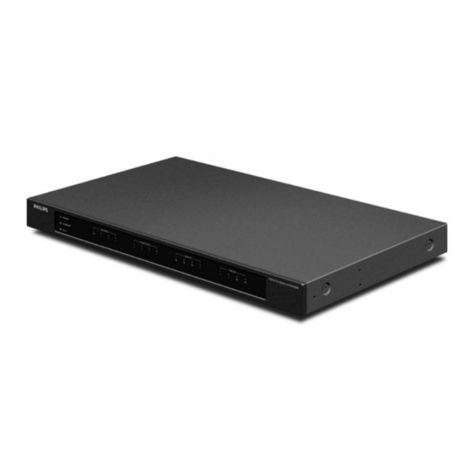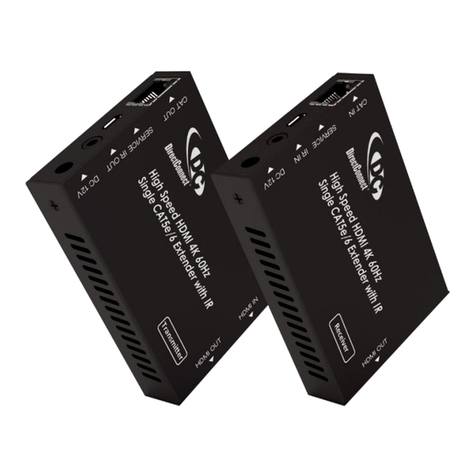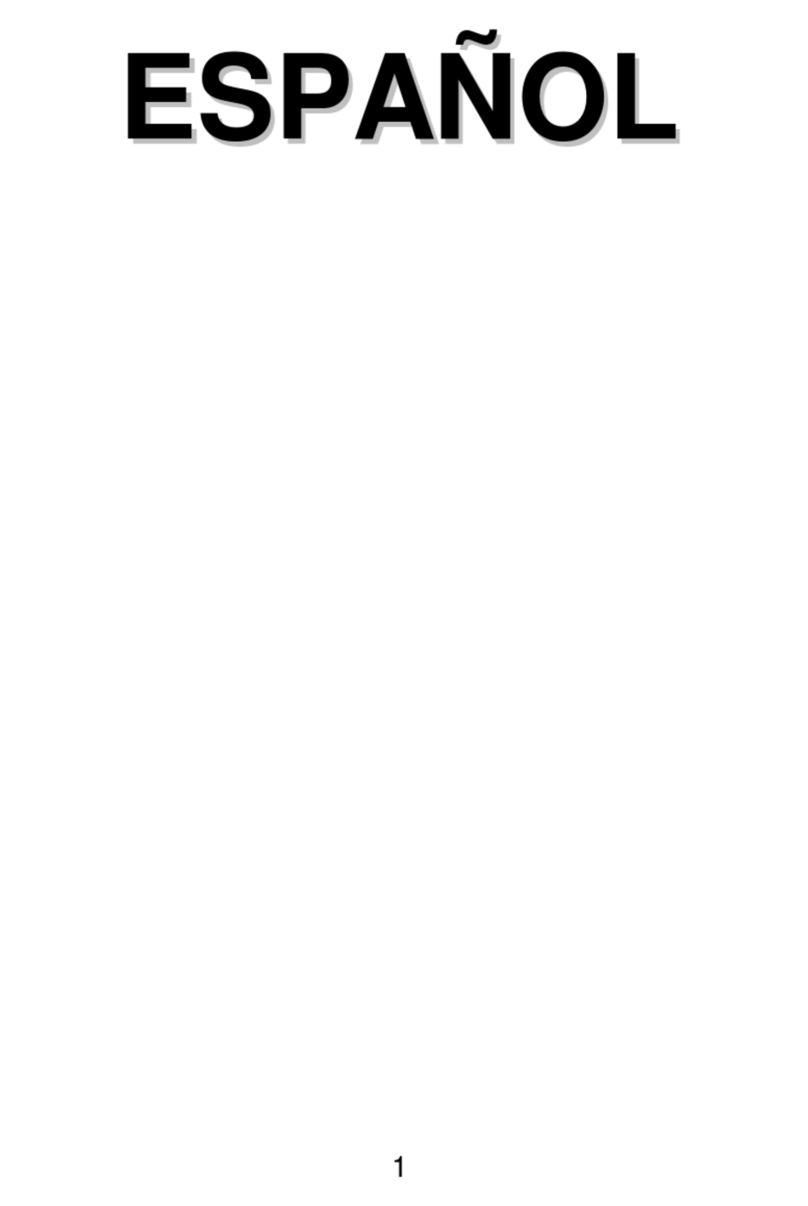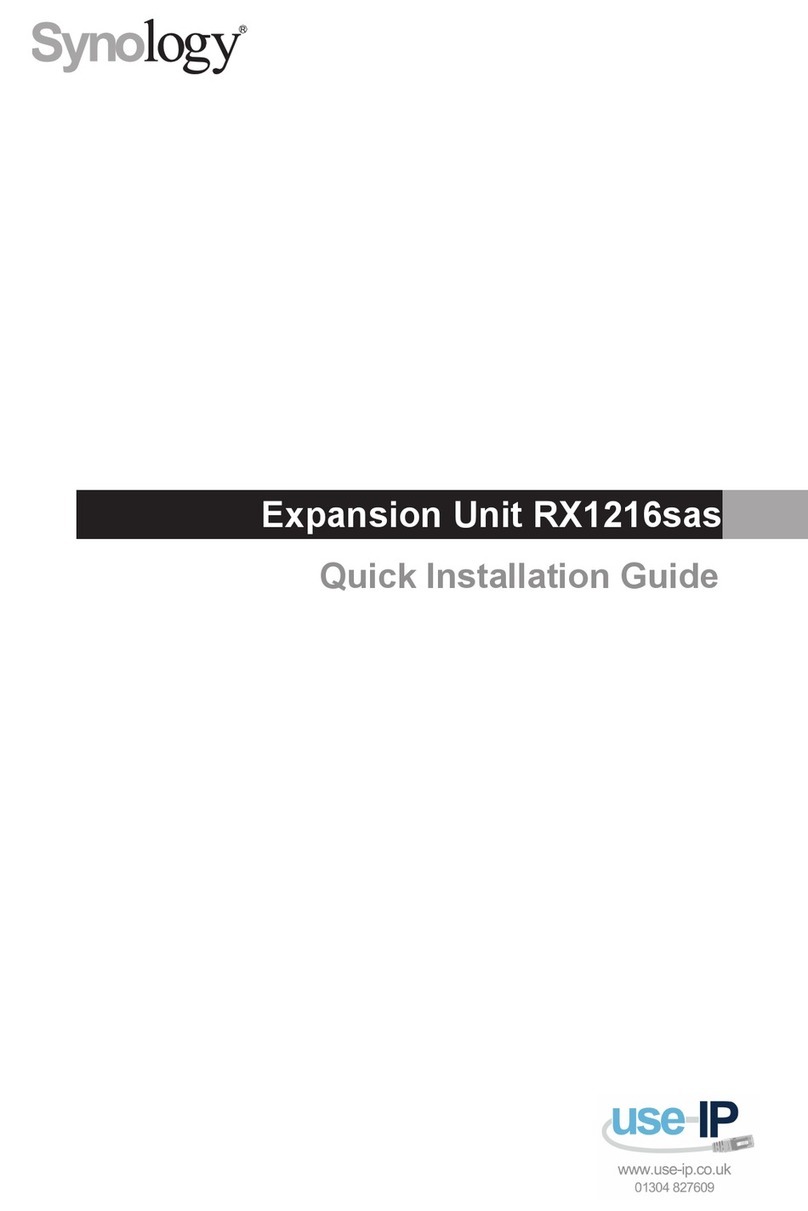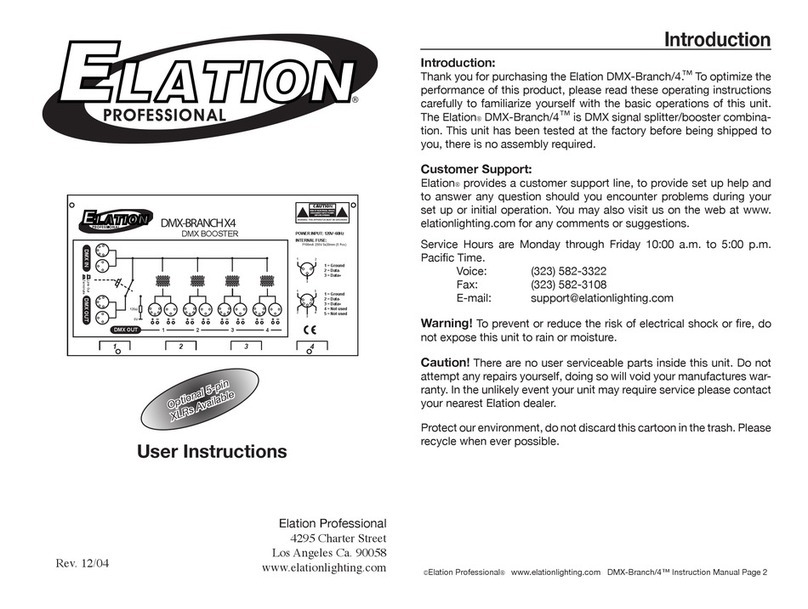esera automation 11162 User manual

Art. No. 11162
All rights reserved. Reproduction as well as electronic duplication of this user guide, complete or in part, requires the written consent of
ESERA GmbH. Errors and technical modification subject to change. ESERA GmbH, ESERA-Automation 2020
www.esera.de 11162 V2.0 R1.0 Manual Page 1 von 5
User Guide
ESERA Extender 4 Linear
Distribution module / Patch panel
for 1-Wire Bus system
Performance features
Distributor for 1-Wire Network in linear topology
7 terminals (push-in) for network cable
1 modular socket for cabling with CAT network cable
Patch field for linear topology and
star-shaped spatial wiring
Housing for DIN rail mounting
Typical areas of application
Central 1-Wire Network distributor
Sub-distributor for 1-Wire network
laboratory equipment, scientific equipment
1 Introduction
Before you start to assemble the 1-Wire Extender 4 and put it into operation, please read this manual carefully to
the end, especially the section on safety instructions.
2 Product description
We call the product a 1-Wire Extender or Distribution Module. However, the terms patch panel, extender, data
distributor or terminal board are also used.
The 1-Wire Extender 4 is designed as a distributor for 1-Wire networks. Due to the 7 push-in terminals no tools
are necessary for the connection. With the 1-Wire Extender 4, the installation and cabling of 1-Wire networks in
linear topology is greatly accelerated and extremely simplified. The 1-Wire Extender 4
can be used, for example, as a central distributor after a 1-Wire bus coupler / 1-Wire controller or 1-Wire hub.
By fitting an 8-pin modular socket, several 1-Wire Extenders 4 can be elegantly connected via
CAT network cables can be connected via a 1-Wire Extension 2 distributor.
The 1-Wire Extender 4 is ideally suited for sub-distribution boards or floor distributors in combination with
DIN rail modules.
The various 1-Wire Extenders form a coordinated cabling system.
For coupling to control systems, we recommend the use of an ESERA 1-Wire controller. This simplifies the
software connection enormously due to the many automatic functions.
No software is required for this module.

All rights reserved. Reproduction as well as electronic duplication of this user guide, complete or in part, requires the written consent of
ESERA GmbH. Errors and technical modification subject to change. ESERA GmbH, ESERA-Automation 2020
www.esera.de 11162 V2.0 R1.0 Manual Page 2 von 5
3 Technical data
Input and output: 1 x RJ45 sockets connected in parallel (12VDC, 5VDC, GND and Data) on Push In
terminal X4
Output: 7 x push-in terminal (5VDC, GND, 1-Wire Data Primary (forward) and 1-Wire Data
Secondary (return)
Termination: A passive bus termination with 4.7kOhm is provided at Push In terminal X7
Use the secondary terminal of the Push In terminal X4
Operating voltage: 5VDC
Operating current: RJ45 socket max. 1.5A, push-in terminals max. 3A
Protection circuits: Reverse polarity protection for 5V input/output
Temperature,operation: -20°C to +60°C
Air humitidy: 10 - 92% (non condensing)
Dimensions: Housing 112x41x 35 (LxWxH)
Protection class: III
Housing protection type: IP00
4 Conformity
EN 50090-2-2
EN 61000-4-2, ESD
EN 61000-4-3, HF
EN 61000-4-4, Burst
EN 61000-4-5, Surge
EN 61000-6-1, interference immunity
EN 61000-6-3, interference radiation
RoHS
5 Connection diagram
The Push In terminals X1 - X3 and X5 - X7 are intended for linear topology (network cabling) of 1-Wire sensors.
The RJ45 modular jack (X8) and the Push In terminal X4 are connected in parallel.
The input signal can be fed to the Push In terminal X4 or the RJ45 modular connector X8.
It is also possible to use terminal X4 and the modular connector (X8) as an adapter from network cable to single
cable. A passive bus termination with 4.7kOhm is provided at Push In terminal X7
Use the secondary terminal of the Push In terminal X4.

Art. No. 11162
All rights reserved. Reproduction as well as electronic duplication of this user guide, complete or in part, requires the written consent of
ESERA GmbH. Errors and technical modification subject to change. ESERA GmbH, ESERA-Automation 2020
www.esera.de 11162 V2.0 R1.0 Manual Page 3 von 5
6 Assignment RJ45 socket (input/output)
The Push In terminal and the RJ45 socket are connected in parallel, which means that both connections can be
used equally.
Socket assignment
1 GND
2 +5VDC
3 GND
4 1-Wire Data
5 GND
6 unoccupied
7 +12VDC
8 GND
7 1-Wire Network
You can find basic information and tips on the 1-Wire bus system in the ESERA Online Shop at:
https://www.esera.de/1-wire-grundlagen/ or you can find from our eBook in the shop under
training/documentation (https://www.esera.de/service-support/dokumentation/352/grundlagen-1-wire-bus-
ebook?number=11901)
8 What does "Linear Topology" mean?
You wire 1-Wire sensors in your building with individual CAT cables and lead the cables to a central location, e.g.
a distribution cabinet. At each 1-Wire sensor you connect the primary and secondary data line in the 1-Wire
terminal. In the distribution cabinet, connect the 5V, GND, secondary and primary data lines to one output of the
Extender 4.
You start with the cable to the
first 1-Wire sensor at terminal X3
second 1-Wire sensor is connected to terminal X2
third 1-Wire sensor is connected to terminal X1
and so on
until you connect the last 1-Wire sensor to terminal X7. The now linear 1-Wire network is terminated with
the secondary data line of the last sensor. For this purpose a passive termination resistor of 4.7kOhm is
integrated within the 1-Wire Extender 4.
Due to the cabling, your 1-Wire sensors are wired in a "star shape", but electrically in a linear topology, which is
the most stable installation form for a 1-Wire network.
Note: Make sure that the total cable length is not more than 50-100m.
8.1 Assignment of CAT cables (ESERA, Maxim and 1-Wire.org)
The ESERA-Automation standard for 1-wire cabling is based on a standardization proposal of 1-Wire.org
(http://www.1wire.org/en-us/p_2.html).
The following definition is an extension of, and does not contradict, the above standard.
1-Wire Pin Assignment (colour specifications according to EIA/TIA 568A (left) or EIA/TIA 568B (right))
1
Green/White
Main supply GND
Orange/White
2
Green
Main supply + (preferably +5V/50mA for 1-Wire devices)
Orange
3
Orange/White
Secondary 1-Wire Bus GND
Green/White
4
Blue
Primary 1-Wire Bus
Blue
5
Blue/White
Primary 1-Wire Bus GND
Blue/White
6
Orange
Secondary 1-Wire Bus
Green
7
Brown/White
Auxiliary supply + (for other consumers, e.g. +12V/200mA)
Brown/White
8
Brown
Auxiliary supply GND
Brown
The only difference between the two colour versions is the interchange of the wire pairs green / green-white and
orange / orange-white. The decisive factor is compliance with the pin numbers.

All rights reserved. Reproduction as well as electronic duplication of this user guide, complete or in part, requires the written consent of
ESERA GmbH. Errors and technical modification subject to change. ESERA GmbH, ESERA-Automation 2020
www.esera.de 11162 V2.0 R1.0 Manual Page 4 von 5
Note:
The shields and filler wires are not connected in terminal points or network sockets.
We recommend connecting the sensors one after the other, starting a search run via the control software and
carrying out the assignment (name / designation). Temperature sensors can also be easily distinguished with the
help of cold spray or heating by hand or hair dryer.
Before commissioning self-wired RJ45 jacks or plugs, we recommend measuring the cables with appropriate
cable test equipment. Incorrect assignment can easily damage bus components.
9 Operating conditions
The device may only be used in dry indoor rooms. The module can be operated in any position.
The device is intended for mounting on top-hat rails, such as those used in fuse cabinets.
10 Assembly
The installation site must be protected against moisture. The device may only be used in dry indoor and protected
outdoor areas.
The device is intended for mounting inside a switch cabinet as a stationary device.
11 Disposal information
Do not dispose of the device in household waste! Electronic devices must be disposed of in
accordance with the Directive on Waste Electrical and Electronic Equipment on local
Dispose of at collection points for old electronic equipment!
12 Safety instructions
When using products that come into contact with electrical voltage, the valid VDE regulations must be observed, especially
VDE 0100, VDE 0550/0551, VDE 0700, VDE 0711 and VDE 0860
All final or wiring work must be carried out with the power turned off.
Before opening the device, always unplug or make sure that the unit is disconnected from the mains.
Components, modules or devices may only be put into service if they are mounted in a contact proof housing.
During installation they must not have power applied.
Tools may only be used on devices, components or assemblies when it is certain that the devices are disconnected
from the power supply and electrical charges stored in the components inside the device have been discharged.
Live cables or wires to which the device or an assembly is connected, must always be tested for insulation faults or
breaks.
If an error is detected in the supply line, the device must be immediately taken out of operation until the faulty cable
has been replaced.
When using components or modules it is absolutely necessary to comply with the requirements set out in the
accompanying description specifications for electrical quantities.
If the available description is not clear to the non-commercial end-user what the applicable electrical characteristics
for a part or assembly are, how to connect an external circuit, which external components or additional devices can
be connected or which values these external components may have, a qualified electrician must be consulted.
It must be examined generally before the commissioning of a device, whether this device or module is basically
suitable for the application in which it is to be used.
In case of doubt, consultation with experts or the manufacturer of the components used is absolutely necessary.
For operational and connection errors outside of our control, we assume no liability of any kind for any resulting
damage.
Kits should be returned without their housing when not functional with an exact error description and the
accompanying instructions. Without an error description it is not possible to repair. For time-consuming assembly or
disassembly of cases charges will be invoiced.
During installation and handling of components which later have mains potential on their parts, the relevant VDE
regulations must be observed.
Devices that are to be operated at a voltage greater than 35 VDC / 12mA, may only be connected by a qualified
electrician and put into operation.
Commissioning may only be realized if the circuit is built into a contact proof housing.
If measurements with an open housing are unavoidable, for safety reasons an isolating transformer must be
installed upstream or a suitable power supply can be used.
After installing the required tests according to DGUV / regulation 3 (German statutory accident insurance
https://en.wikipedia.org/wiki/German_Statutory_Accident_Insurance) must be carried out.

Art. No. 11162
All rights reserved. Reproduction as well as electronic duplication of this user guide, complete or in part, requires the written consent of
ESERA GmbH. Errors and technical modification subject to change. ESERA GmbH, ESERA-Automation 2020
www.esera.de 11162 V2.0 R1.0 Manual Page 5 von 5
13 Warranty
ESERA GmbH guarantees that the goods sold at the time of transfer of risk to be free from material and workmanship
defects and have the contractually assured characteristics. The statutory warranty period of two years begins from date of
invoice. The warranty does not extend to the normal operational wear and normal wear and tear. Customer claims for
damages, for example, for non-performance, fault in contracting, breach of secondary contractual obligations,
consequential damages, damages resulting from unauthorized usage and other legal grounds are excluded. Excepting to
this, ESERA GmbH accepts liability for the absence of a guaranteed quality resulting from intent or gross negligence.
Claims made under the Product Liability Act are not affected.
If defects occur for which the ESERA GmbH is responsible, and in the case of replacement goods, the replacement is
faulty, the buyer has the right to have the original purchase price refunded or a reduction of the purchase price.
ESERA GmbH accepts liability neither for the constant and uninterrupted availability of the ESERA GmbH or for technical
or electronic errors in the online offer.
We are constantly developing our products further and reserve the right to make changes and improvements to any of the
products described in this documentation without prior notice. Should you require documents or information on older versions,
14 Trademarks
All mentioned designations, logos, names and trademarks (including those which are not explicitly marked) are
trademarks, registered trademarks or other copyright or trademarks or titles or legally protected designations of their
respective owners and are hereby expressly recognized as such by us. The mention of these designations, logos, names
and trademarks is made for identification purposes only and does not represent a claim of any kind on the part of ESERA
GmbH on these designations, logos, names and trademarks. Moreover, from their appearance on ESERA GmbH
webpages it cannot be concluded that designations, logos, names and trademarks are free of commercial property rights.
ESERA and Auto-E-Connect are registered trademarks of ESERA GmbH.
15 Contact
ESERA GmbH
Adelindastrasse 20
87600 Kaufbeuren
GERMANY
Tel.: +49 8341 999 80-0
Fax: +49 8341 999 80-10
www.esera.de/
WEEE-Number: DE30249510
Table of contents

